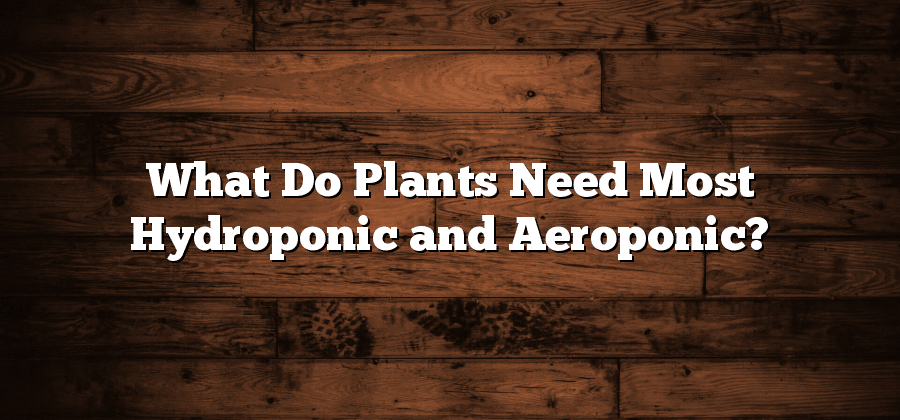The Importance of Water in Hydroponic and Aeroponic Systems
Water is a crucial element in hydroponic and aeroponic systems, playing a vital role in providing plants with the necessary nutrients and maintaining their overall health. Unlike traditional soil-based cultivation, these systems rely on water as the primary medium for nutrient delivery, making its quality and availability paramount. The quality of water used in hydroponic and aeroponic systems directly affects plant growth and yields, as well as the efficiency of nutrient uptake. Therefore, it is essential to understand the characteristics of water and how it interacts with the plants in these systems.
The pH level of water is an important factor that influences nutrient availability and uptake in hydroponic and aeroponic systems. Different plants have specific pH requirements, so it is crucial to measure and adjust the water’s pH accordingly. Additionally, the water’s mineral composition, including the presence of calcium, magnesium, and trace elements, should be monitored and balanced to ensure optimal plant growth. Moreover, the temperature of the water plays a significant role, as it affects nutrient absorption and microbial activity. By maintaining an appropriate water temperature, growers can further enhance the overall health and productivity of their plants in hydroponic and aeroponic systems.
Understanding Nutrient Requirements for Hydroponic and Aeroponic Plants
Hydroponic and aeroponic systems provide an innovative way to cultivate plants without the use of soil. Instead, these systems rely on nutrient-rich solutions to supply plants with the necessary minerals and elements for growth. Understanding the nutrient requirements for hydroponic and aeroponic plants is crucial for maximizing their potential and achieving optimal yields.
In these systems, the nutrients that plants typically obtain from soil are dissolved in water and delivered directly to the roots. This allows for precise control over the nutrient composition, ensuring that plants receive a balanced diet tailored to their specific needs. Essential macronutrients such as nitrogen, phosphorus, and potassium are typically present in higher quantities, while micronutrients such as iron, manganese, and zinc are supplied in smaller amounts. Monitoring and adjusting the nutrient solution regularly is necessary to maintain the right balance and prevent deficiencies or toxicities. With the right combination of nutrients, plants can thrive and produce abundant, high-quality harvests.
Oxygenation: A Vital Element for Healthy Hydroponic and Aeroponic Plants
Oxygenation is a critical factor in ensuring the health and vitality of plants grown in hydroponic and aeroponic systems. Without adequate levels of oxygen, plant roots can become deprived and begin to suffocate, leading to poor growth and potential crop failure. Proper oxygenation helps to facilitate nutrient uptake, root development, and overall plant metabolism, ultimately contributing to higher yields and healthier plants.
There are several methods for oxygenating the root zone in hydroponic and aeroponic systems. One common approach is the use of air stones or diffusers, which release bubbles of oxygen into the nutrient solution. This ensures that the roots are constantly supplied with oxygen, allowing them to respire efficiently. In addition, oxygenation can also be enhanced by incorporating aeration devices such as air pumps and air lift systems, which increase circulation and oxygen exchange within the system. Overall, a well-oxygenated root zone is vital for promoting robust plant growth and maximizing the potential of hydroponic and aeroponic systems.
Temperature Control: Creating the Ideal Environment for Plant Growth
Temperature control plays a crucial role in providing the ideal environment for plant growth in hydroponic and aeroponic systems. In these controlled environments, maintaining the optimal temperature range is essential for the health and productivity of the plants.
One key aspect of temperature control is avoiding extreme fluctuations. Sudden changes in temperature can be detrimental to plants, causing stress and negatively impacting their growth. By maintaining a stable temperature, within the preferred range for the specific plants being grown, growers can help ensure healthy and vigorous growth. Additionally, consistent temperatures can also help minimize the risk of diseases and pests, as many of them thrive in specific temperature ranges.
Lighting Considerations for Hydroponic and Aeroponic Systems
When it comes to hydroponic and aeroponic systems, proper lighting is crucial for the health and productivity of the plants. Unlike traditional soil-based gardening, where plants have natural access to sunlight, hydroponic and aeroponic systems require artificial light sources to mimic the sun’s rays. This is because these systems are often set up indoors or in enclosed spaces where sunlight may not be readily available.
Choosing the right lighting for your hydroponic or aeroponic system is essential to ensure optimal plant growth. There are a few factors to consider when selecting lighting fixtures, such as the type of plants you are growing, the stage of growth they are in, and the size of your growing area. Additionally, the spectrum of light emitted by the fixtures is also important, as different plants have varying light requirements. High-intensity discharge (HID) lamps, fluorescent lights, and light-emitting diode (LED) lights are commonly used in hydroponic and aeroponic systems. Each has its own advantages and disadvantages, and it is important to choose the one that best suits your specific needs.






